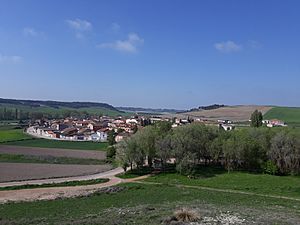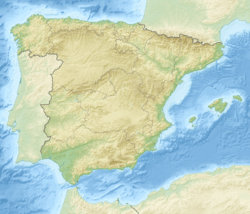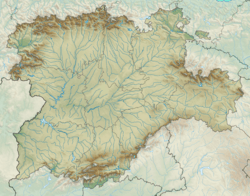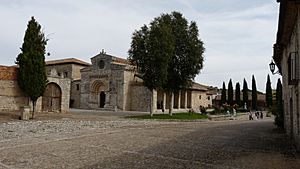Wamba, Valladolid facts for kids
Quick facts for kids
Wamba
|
|
|---|---|
 |
|
| Country | Spain |
| Autonomous community | Castile and León |
| Province | Valladolid |
| Area | |
| • Total | 38.16 km2 (14.73 sq mi) |
| Population
(2018)
|
|
| • Total | 328 |
| • Density | 8.595/km2 (22.26/sq mi) |
| Time zone | UTC+1 (CET) |
Wamba is a small town in Spain. It is a municipality located in the province of Valladolid, which is part of the Castile and León region. The town covers an area of about 38 square kilometers. As of January 1, 2020, Wamba had a population of 310 people.
Contents
Where is Wamba Located?
Wamba is found in the southeast part of an area called Montes Torozos. It shares borders with several other towns. These include Peñaflor de Hornija, Villanubla, Ciguñuela, and Castrodeza. It also borders a small part of the city of Valladolid and the town of Torrelobatón.
The town is also located on the Camino de Santiago de Madrid. This is one of the many routes that make up the famous Way of St James. Many people walk these paths each year.
The Story Behind Wamba's Name
The name of the town, Wamba, comes from a very old king. This king was called King Wamba. He was chosen to be king in this very town in the year 672. Back then, the town had a different name: Gérticos.
Before King Wamba, another king named Recceswinth had a country house here. King Receswinth died in Gérticos. Right after his death, the important people of the time chose Wamba to be the new king.
It's interesting to know that Wamba is the only town in Spain whose name starts with the letter 'W'.
Amazing Old Buildings in Wamba
St. Mary's Church
Wamba is home to a very old church called St. Mary's Church. We know there was a church here even in the time of the Visigoths. These were people who lived in Spain a very long time ago. Pieces of decoration from their church can still be seen in a museum in Valladolid.
After a period called the Reconquista, when Christians took back land in Spain, the old church was likely rebuilt. This new building might have been the first Mozarabic church in the area. Mozarabic art is a style created by Christians living under Muslim rule.
Some people believe that new residents came from the north to live in Wamba. This might be why St. Mary's Church looks more like Visigothic and Asturian churches. It is different from other churches built around the same time.
The oldest part of the church that still stands is the East End. This includes the first part of the main church area and the entire north wall. The rest of the church was changed and made bigger in the late 1100s. At that time, St. Mary's Church became connected to the Knights Hospitaller. This was a group of knights who helped people and protected pilgrims.
The church also has a special room with a unique ceiling. Inside the church, you can find old paintings and sculptures from different times.
The Queen's Burial Place
A queen named Urraca of Portugal was buried in St. Mary's Church. She was the wife of King Ferdinand II of León. She was also the mother of King Alfonso IX of León. After her marriage ended, she became a nun with the Knights Hospitaller.
There is a special chapel called the Queen's Chapel. Here, you can find a stone with writing on it. This writing tells us that Queen Urraca of Portugal was buried in this church. She was the daughter of Afonso I of Portugal and his wife Matilda of Savoy, Queen of Portugal.
The Ossuary
The church also has a large room called an ossuary. This is a place where bones of people who have passed away are kept. For many centuries, from the 1200s to the 1700s, thousands of bones were placed here.
Gallery of the Ossuary
See also
 In Spanish: Wamba (Valladolid) para niños
In Spanish: Wamba (Valladolid) para niños









